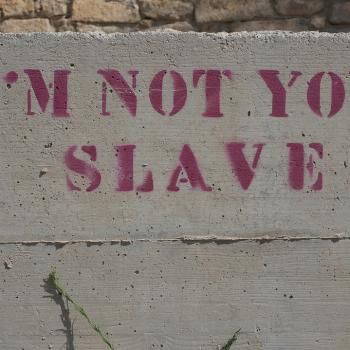
There are so many stories throughout the Hebrew Scriptures that are, well, simply perplexing. Tales of genocide and ethnic cleansing, of warring tribes, backed by violent tribal deities, fill the pages. Cities are crushed by fire and brimstone that falls from the heavens. Disobedience gets you turned into a pillar of salt, while “pulling out early” lands you the punishment of instant death. And don’t even dare think about trying to (non-consciously) catch the Ark of the Covenant before it falls to the ground or you’ll wind up in the same state as the aforementioned seed-spiller, Onan. I could go on and on but I don’t think I have to as you hopefully see my point. It can be a tad crazy, no?
So the question is raised: How are we, as 21st-century Christians—hopefully living with a worldview that doesn’t include the belief that there is a G-d out there who gets really pissed if you touch “his treasures”—going to explain the events contained in the Hebrew Scriptures? Or should we even try? I suppose that we could do what I have heard countless conservatives do, which is; chalk it all up to “God’s mysterious ways.” But that doesn’t really help if we are ever going to conclude that God is exactly like Jesus, which is really what Christians should be doing (see John 5:19–20; 6:38; 8:28; 10:29–30; 12:49, and Colossians 2:9). I mean, we can’t honestly say both: “God is exactly like Jesus,” and “the divine violence in the Old Testament literally happened, as it ‘clearly’ states,” can we?
There has to be a way to explain some of this, right?
Well, yes, I believe there is, and so that is exactly what I am going to attempt to model in this two-part series. But first, I am going to have to introduce the work of René Girard, as his anthropological insights, being second to none, offer a way to explain much of the anthropology contained within the Scriptures. This will be crucial in explaining why we tell our stories in the ways we do, and then also why we say the things we say about the divine.
That being said; let us now take a look at who we are as a species and what informs how we behave.
The first thing that we must understand about the human being is that our desires are non-consciously derived by the desires of the other. In essence, we are all copycats of each other, all models of the other. I know this is hard to accept here in the US, where autonomy is king. But it is true nonetheless, for should our desires be fixed, they would simply be a form of instinct (Girard, I See Satan Fall like Lightning, 15). If you don’t believe me, pay attention to the fashion industry, who seem to always use celebrities and other attractive and powerful men and women to model their clothing. They do so in hopes that we will desire them simply because those we look up to do. And you know what? It works! Why? Because our desires are mimetic, an imitation of those we take on as models. For another quick example, just ask yourself what happens when two children are in a room full of toys. Sure enough, more often than not, they will fight over one toy, won’t they? It doesn’t really matter which toy, as conflict seems to come to fruition as soon as one shows interest in a particular one. Again, this is due to our mimetic hardwiring.
This is where the problem arises. When we desire what our neighbor desires, we become rivals for the shared object of desire. This can lead to all kinds of breakdowns within a community. Rivalries will pop up left and right and violence will inevitably become all-against-all. In an essay for The Raven Foundation, entitled “The Root of Violence: Imitative Desire, Death Anxiety, and the Gospel’s Solution to Both,” I explained how a community spares itself from this violent trend:
To quell this violence, Girard noticed, communities then turn to a third party to blame for all of the societal problems. This phenomenon is called the scapegoating mechanism. Instead of communal violence that is all against all, which has the potential to spiral out of control and destroy the entire community, the people displace their violence onto one member or subgroup. This unifies the community and in turn leads to peace, albeit temporarily so, as the process inevitably repeats itself as the community progresses throughout history. Paradoxically, in the eyes of the community, the scapegoat is then viewed as the source of the conflict but then as the bringer of peace. The transformation from violence that threatens the survival of the community to peace that envelops it is the reason why this sort of mediated violence against the one is often seen as sacred. (Distefano, “The Root of Violence,” 1–2)
So, to summarize up to this point: human beings desire what the other desires, which leads to rivalry and eventually, unmediated violence. In an attempt to mediate this violence, hostilities are placed onto a surrogate, a scapegoat. He is sacrificed and catharsis ensues.
Allow me to explain how this process then informs how we structure our cultures and religions. Then, with this in mind, we can get into some of the ways in which the Hebrew Scriptures can be seen as “inspired” and rather progressive when compared to other ancient faith traditions.
Girard explains how all human cultures contain “three pillars,” as he calls them. First, he noticed that prohibitions arise from the community’s attempt to pinpoint the thing or behavior that led to their violence in the first place. This is done with the hope that by making something taboo; they won’t end up in the same mess they just got out of. This is how religious and cultural laws are born. Second, rituals are the re-enactments of the original sacrifice of the surrogate victim. Because the scapegoated victim is seen by the community as the bringer of peace—and he was!—the ritual attempts to emulate this as best as possible in hopes that peace within the community remains. If it worked before, it is safe to assume it will work again. This is how the practice of “sacrificing to the gods” is born. Finally, mythology is the way in which the community tells this tale. In short, myth states: the gods approve of our violence. Of course they did, otherwise why would the sacrifice of the scapegoat have worked to bring about peace?
And so, our mythologies are religious tales of how a very specific type of violence is viewed as divine in origin.
Now this is obviously the “elevator pitch” explanation of the mimetic theory. Much more would need to be said if we are going to understand all the inner workings of the theory. But for our purposes in this essay, it will have to do.
That being said, what we will do now is take a bird’s eye view of the Hebrew Scriptures, focusing primarily on how the Hebrew writers offer amazing theological and anthropological revelations. We’ll specifically cover 7 of them. Now, while there indeed contains plenty of mythology throughout the Scriptures, take comfort that this fact is okay, because instead of flat, biblical truths, what we really find is a progressive revelation of God and humanity, ebbing and flowing and remaining somewhat in tension throughout.
(That tension will eventually lead us to Jesus, who I will discuss in Part 2 of this series. Now though, let’s get into the Hebrew Scriptures, beginning with the book of Genesis.)
Revelation 1: Non-Violent Creation
Because violence was such a large part of humanity’s past, most creation myths included a violent divine back-story (see, for example, Enuma Elish, and the Mandé and Tungusic creation myths). But this is not the case with the first creation story in Genesis. (Yes, there are two.)
The first narrative is Genesis 1:1–2:3 and tells a tale of a God who creates by breathing things into existence. Not only that, but he creates humanity in “his” very image, rather than as a mere afterthought, like in the Babylonian genesis, Enuma Elish. I’ll note that I put scare quotes around “his” because in reality, God’s image is “male and female” (Genesis 1:27). Thus, God is relational. This too is unique to the Hebrew Genesis story.
And, lastly, he also gives all created things to humanity for them to enjoy. This not only includes dominion over all living beings (Genesis 1:28), but also includes all plants and trees for food (Genesis 1:29—my emphasis). This will be contrasted by the writer of the second narrative.
Revelation 2: Desire and the Fall
In the second creation narrative (Genesis 2:4–3:24), the story is quite different. And that is okay as the point of the story is different. This account starts out with a prohibition of a tree of knowledge of good and evil (Genesis 2:17). Remember, prohibitions are a civilization’s attempt to quell violence by deeming it culturally taboo. Thus, this is a profound way of pointing to that which causes humanity the greatest conflict, which is, to be like God in judging “good” from “evil.” If we meditate on this, then we will probably realize that that is exactly what has caused humanity her greatest problems and has led to the most violence throughout history. All of it, “with God on our side,” as the great prophet Bob Dylan put it.
The problem with prohibitions, then, is that while they do in fact stop people from doing something (for a time), they also increase desire. And so, desire becomes twisted and consumes our minds. That is what the serpent represents. He is the twisted desire that arises from us saying: “Do not push the red button!”
And so, once Eve follows the serpent and eats from the tree, because of our mimetic desire, Adam quickly follows suit. He even does so without as much as a second thought. That is because, like I said earlier, this phenomenon is non-conscious, or as Scott Garells puts it: “is below phenomenological awareness.” (Garells, “Imitation, Mirror Neurons, and Mimetic Desire,” 81)
Then, the two are said to be exiled from the garden. This happens, not because of Adam and Eve’s “rule-breaking” per se, but because they have now taken on each other as models, rather than God, whose image they bear. And when we take on each other as models, it will eventually lead to violence, as I introduced earlier.
In God’s Eden, there is no violence so expulsion was the only way.
Revelation 3: Founding Murder
One generation later, violence indeed ensues. But the murder of Cain and Abel need not be seen as some isolated, historical event, but rather, how all civilizations and cultures are founded. The city of Rome is founded after Romulus kills his brother Remus. The Greek city of Thebes is founded after Cadmus slays a dragon. After Cain kills Abel, he founds Enoch (Genesis 4:17).
But there are great differences in the Hebrew account so we need to pay attention.
In the mythology of Romulus and Remus, for instance, Romulus, the killer of his brother Remus, is immortalized, as the city of Rome is named after him. Romulus is essentially the hero of the story. But in the Genesis account, Cain is simply in the wrong. Abel’s blood even cries for vengeance from the grave (Genesis 4:10). And this is a justified cry, as blood was unjustly spilled.
But God would have none of it. Notice how he does two things. First, he places a mark on Cain (Genesis 4:15) so that retribution will not be had by anyone. Second, he warns that “whoever kills Cain will suffer a sevenfold vengeance” (Genesis 4:15). This isn’t some threat of divine vengeance but rather, more akin to prophecy as only six generations later, a man named Lamech is murdering left and right, for minor things like being hit by a boy (Genesis 4:24). Talk about overkill! But, such is the case with retributive “justice.”
Revelation 4: The Cause of the Flood
After a time, violence gets really out of hand. (As if it wasn’t already!) In fact, this is what the writer of Noah’s flood says causes the deluge. In Genesis 6:11–13, on multiple occasions, it is said that “the entire earth was corrupt and filled with violence.” Michael Hardin points out: “to be corrupt and full of violence is one and the same thing: this is what scholars call parallelism in Hebrew writing.” (Hardin, Jesus Driven Life, 176) Correlating the flood to violence is completely unique to the Hebrew Scriptures, as neither the Babylonian Epic of Gilgamesh, nor the Akkadian Epic of Atra-Hasis suggests violence is the problem.
I will note that the mythology here is the belief that God sends curses upon the earth whenever humanity becomes wicked. Sure, some epic event assuredly took place, but it was sent by God no more than hurricanes and tidal waves are today. It was just the only way to explain such a destructive natural disaster.
Revelation 5: Thou Shalt Not Desire
Like the story of Adam and Eve, the tenth commandment (Exodus 20:17), sheds direct light on how problems arise due to mimetic desire. After 4 separate prohibitive commandments—in order from most to least violent—commandment ten tells us to not desire what those closest to us have. It matters not what that thing is, whether it is your neighbor’s wife, his slave, his ox, or donkey, it is desirable because your neighbor has it. In the modern age, perhaps it would be your neighbor’s “crib, spouse, iPad, ps4, or BMW.” But again, it doesn’t matter. The problem is the increase in desire simply because it belongs to your neighbor. It is so powerful that it will lead to the aforementioned prohibited behaviors, namely, murder, adultery, theft, and false witness. That is why that which belongs to our neighbor must be prohibited.
That being said, the problem with prohibitions, as I mentioned before, is that they actually increase desire for the prohibited item. So, in a way, they are rather self-defeating. That is why when Jesus interprets the prohibitive commandments, he does something rather unique. But you will have to wait, as we will get to that in Part 2.
Revelation 6: Progression Away from Sacrifice
Archaic religions were centered on sacrifice. Earlier, I briefly mentioned how this violent practice originated. The Jewish faith, then, at least early on, was no different. What is different is that the Hebrew Scriptures do in fact take us away from this practice.
I will briefly mention a few of the ways.
First, in Genesis 22, we have the story of how God is said to have commanded Abraham to sacrifice his son Isaac. Looking at the text, what is interesting to note is that in every instance where God instructs Isaac to go forward with the slaying, the generic Hebrew tern for God (El) is used. However, when Abraham is commanded to stop, it is from an angel of (Yahweh). In short, this should be our hint that the writer is trying to tell us something, which is: “Even though everyone assumes God wants first born son to be sacrificed on an altar, he actually doesn’t.” Much more would need to be said about this, but since this essay is running rather long already, I will leave it at that. I do, however, cover Genesis 22 at length in my forthcoming book, From the Blood of Abel: Humanity’s Root Causes of Violence and the Bible as a Theological-Anthropological Solution.
The second move away from the practice of sacrifice is thanks to the Jewish prophets. They question, even denounce, the entire sacrificial system laid out in Torah (primarily in the book of Leviticus). The strongest anti-sacrificial statement is made by the prophet Jeremiah, specifically in Jeremiah 7:21–22. He states: “Thus says the Lord of hosts, the God of Israel: Add your burnt offerings to your sacrifices, and eat the flesh. For in the day that I brought your ancestors out of the land of Egypt, I did not speak to them or command them concerning burnt offerings and sacrifices.” In other words, even though Moses conveyed God’s sacrificial desires, Jeremiah contradicts him.
But he wasn’t the only one. For other anti-sacrificial prophetic statements, see Micah 6:6–7, Psalm 40:6; 50:8–15; 51:15–17; 69:30–31, Jeremiah 6:20, Hosea 6:6, Isaiah 1:10–15, and Amos 5:21–24.
Revelation 8: The Voice of the Victim
The final revelation I would like to introduce is what I will call “the voice of the victim.” This is important for Christians because we claim to follow the ultimate victim, Christ Jesus. But this concept will be scattered throughout the Jewish Scriptures as well. As I mentioned earlier, it is introduced when Abel’s blood cries for vengeance from the grave (Genesis 4:10). But the voice of the victim changes when we get to other places. In Job, his voice isn’t so much vengeful, but lamenting. When we get to the Suffering Servant of Second Isaiah, the voice of the servant is mute, yet he is vindicated by God, as “out of his anguish he shall see light; he shall find satisfaction through his knowledge” (Isaiah 53:11). Finally, when we get to Jesus though, we will see how the voice of this victim is primarily not mute or lamenting, and assuredly isn’t vengeful, but forgiving (Luke 23:34).
In the next part of this series, we will explore how Jesus is the culmination of this progressive revelation we have been touching on. He will be, as my friend Tony Bartlett puts it, a “new theological-anthropological truth” (Bartlett, “Isaiah 53,” in Jesus Driven Life, 201). So, stay tuned for that . . .

















